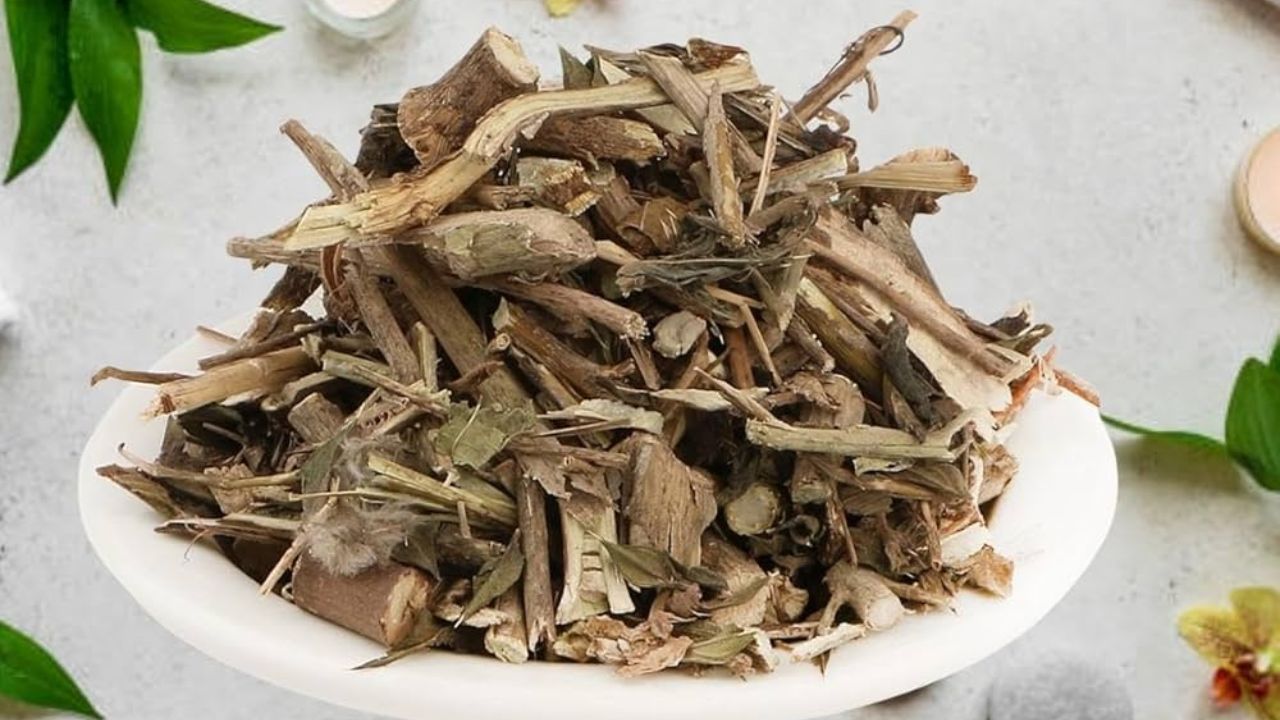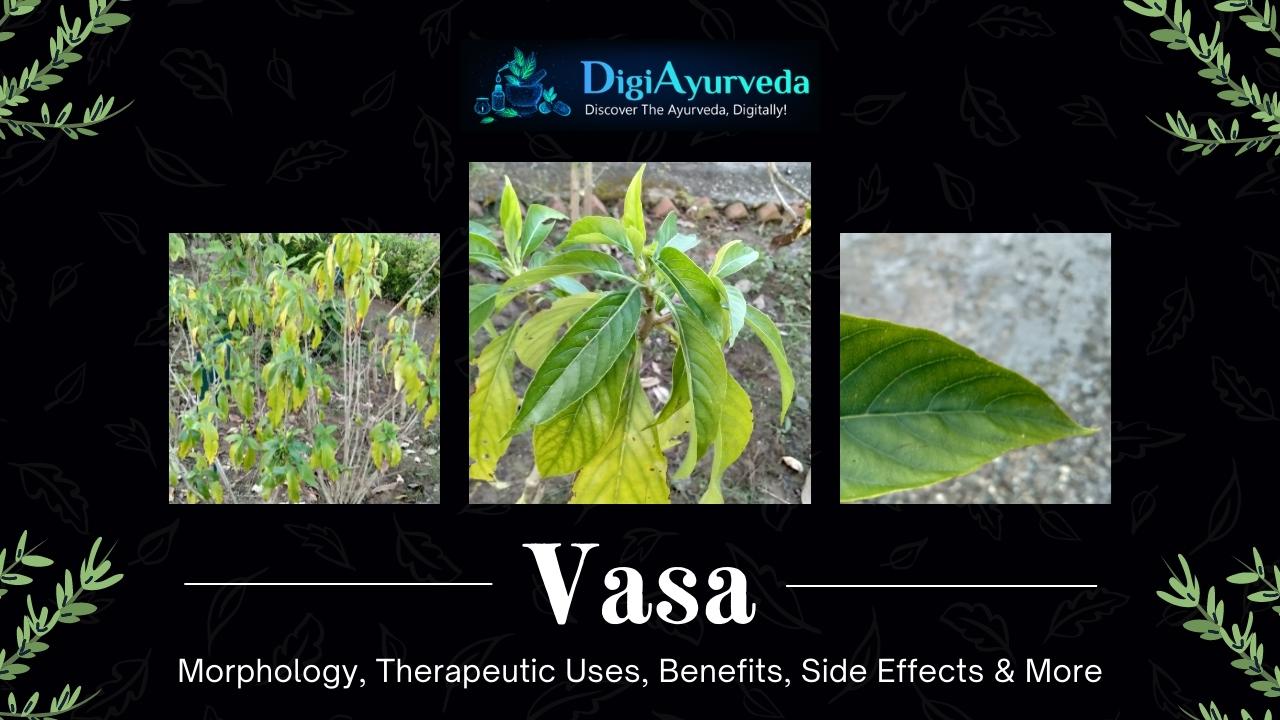
Family : Acanthaceae
Biological classification
- Kingdom: Plantae
- Subkingdom: Viridiplantae
- Division: Tracheophyta
- Subdivision: Spermatophytina
- Class: Magnoliopsida
- Order: Lamiales
- Family: Acanthaceae
- Genus: Justicia L.
- Species: Justicia adhatoda L.
Introduction To Vasa
Justicia adhatoda commonly known in English as Malabar nut, adulsa, adhatoda, vasa, vasaka. It reduces kapha Dosha by Laghu, Ruksha, and tikta-kashaya . It also reduces pitta Dosha by tikta-kashaya and shitta virya. It may be indicated in fever dysuria inflammation in urine diabetes skin disorders asthma attacks.

Habitat / place of origin
Plant’s native range is Afghanistan, the Indian subcontinent (Assam, Bangladesh, India, Pakistan, Nepal and Sri Lanka), Laos, Myanmar and Vietnam. It has been introduced elsewhere.
Synonyms of Vasa
Sanskrit: Vasa, Vasika Vasak, Sihasaya, Vajidant, Vrish, Aatrushak,
Assamese: Tibabahak , Bahak , Vachaka
Bengali: Vasak
English: Malabar Nut
Gujarati: Ardusi
Hindi: Adusa , Vasak
Kannada: Atarusha , Adsale , Adsole , Adasale, Adusoge ,
Kashmiri: Vasa
Malyalam: Attalataka , Atalotakam
Marathi: Adulasa
Oriya: Basabga
Punjabi: Vansa
Tamil : Aidhadad
Telugu : Adasara
Unani: Azusa , Basa
Morphology of Vasa
Stem : A dense glabrous shrub up to 0.5 to 1 m.
Leaves :Simple ,opposite and alternate leaves pattern elliptic or elliptic-lanceolate, acuminate.
Flower: White, dense spikes ; bracts ovate or obovate; calyx deeply five-lobed; stamens are glabrous.
Fruit : Four seeded capsules with a solid base. Seeds— glabrous
Flowering time: February- march
Fruiting time : February- march
Medicinal Parts of Vasa
Root , Leaves , and Flowers
Plant variety of Vasa
- Justicia gendarussa
- Adhatoda beddomei
Chemical Composition of Vasa
- It is widely used as a natural expectorant.
Vasa has a rich concentration of bioactive components :
- Vasicine
- Luteolin
- Carotene
- Vasakin
- Other quinazoline alkaloids,
- And essential oils.
- The leaves are abundant in phytochemical constituents like alkaloids, tannins, flavonoids, saponins, and phenolics etc.
Ayurvedic Properties of Vasa
Rasa (Taste) : Tikta , Kashaya
Guna (Quality) : Ruksha , Laghu
Virya (Potency) : Shitta
Vipak (Post Digestive Effect): Katu
Karma (Pharmacological Actions)
Dosha Karma: It is Kaph -Pitta Shamak.
Sansthsanik Karma (General Indications ): Shoth Har , Vednasathapan , Jantughan , Kushthghan
Nadisansthan (Cns ): Avsadan Kriya
Pachnasansthan (Digestive System ): Stambhan
Raktvahsansthan (Cvs): Hridya , Raktshodhak , Rakt Stambhan ,
Sawasansthan (Reproductive System ): Kapha-Har , Shleshm har , Kanthaya , Swashar
Mutravahsansthan (Urinary System ): Mutrajanana
Tavcha (Skin): Sawedjanan, Kusthghan
Tapkarma (Thermoregulations ): Jwarghan
Kashya-Har
Qualities/Effects on Tridosha of Vasa
It reduces kapha Dosha by Laghu, Ruksha, and tikta-kshaya . It also reduces pitta Dosha by tikta-kshaya and shitta virya.
Formulations of Vasa
- Vasa-Avaleha
- Vasarishtha
- Vasa-panak
- Vasa Chandan Aadi tail
Therapeutic Uses of Vasa
- It is indicated in fever
- It is indicated in dysuria
- It is indicated in inflammation in urine
- It is indicated in diabetes
- It is indicated in skin disorders
- It is indicated in asthma attacks
- It is indicated in cough and blood mixed cough
- It is indicated in TB
- It is indicated in cardiac disorders
- It is indicated in hemorrhoids
- It is indicated in blood disorders
- It is indicated in diarrhea and dysentery
- It is indicated in worm infestations
- It is indicated in epilepsy , seizures
- It is indicated in kapha-pittaj diseases
- It is indicated in inflammation around wounds
Dosage
- Vasaka leaf powder: 1 – 3 gm
- Flower powder: 250 – 1000 mg
- Root powder: 250 – 500 mg
- Leaf juice: 5 – 10 ml
- Leaf Decoction: 5gm powder in a glass of warm water
How can you consume Vasa?
It is administered in the form of lepa (paste ) , in the form of swarasa , kwath and juices . It is used in different formulations . A decoction of Vasa leaves by boiling the leaves in water. Add a spoon of honey and drink it.
Benefits of Vasa
- Recurrent coughs and congested throat , also used in treating the common cold, cough and flu symptoms. Tuberculosis
- It also help to reduces chest and nasal congestion and eliminates excess sputum and stops nasal discharge.
- It is Used in treatment of sinusitis, asthma, bronchitis, and other respiratory diseases.
- It helps to eliminate abdominal gas and reduces bloating, abdominal distension, and gaseous cramps.
- It is used to treat gastrointestinal disorders like esophagitis, dyspepsia, heartburn, diarrhea, flatulence, peptic ulcer and gastroesophageal reflux disease
- It used to purifying the blood.
- It improves blood count, manages blood pressure.
- It protects from blockage and formation of clots in the arteries causing heart block.
- It boosts the immunity
- It prevent bacterial infestation.
- It used in fever like dengue fever ,
- It prevents allergic conditions on the skin.
- It helps in reducing ulcers (peptic and duodenal ulcers )
- It helps in treatment of bleeding disorders
- It relief from pain and inflammation of arthritis and joint pain.
- It helps in eliminating the toxic wastes from the body through urine and it improves the urinary functions.
- It is Used in skin infections like boils, blisters, acne, warts, eczema, itching etc
- It clears the skin tone, clears blocked pores, and also reducing various signs of ageing.
- It prevents wounds and injuries and facilitates healing.
- Used in Sunburn.
Side Effects of Vasa
Use under prescription while talking with it during pregnancy, lactation or if you have any chronic disease
Safety Precautions of Vasa
- Avoid Adoosa during breastfeeding.
- Avoid Adoosa during pregnancy. It has abortifacient property. It stimulates the uterine contractions.
Substitutes & Adulterants
Adulteration:
- Ailanthus excelsa -[ad]
- A. beddomei
References & Further Reading
- https://www.netmeds.com/health-library/post/vasaka-health-benefits-usage-dosage-and-side-effects-of-malabar-nut
- https://www.daburchyawanprash.com/immunity-boosting-foods/vasa-ayurvedic-herb-for-boosting-immunity.aspx
- https://www.1mg.com/ayurveda/adoosa-84
- https://www.webmd.com/vitamins/ai/ingredientmono-1/malabar-nut
- THE API (AYURVEDIC PHARMACOPOEIA OF INDIA) , PART-1 , VOLUME-II
- DRAVYAGUNA VIGYAN =PV SHARMA




